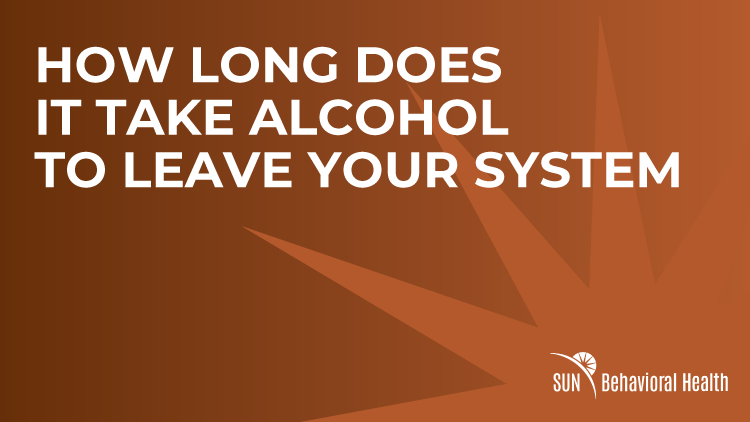Services
- Home
- Mental Health
- Who We Treat
- How We Treat
- Patients & Visitors
- About
- Lexington
close

Approximately 1 million people were arrested in 2019 for driving while under the influence. This can come both from the lowered reaction time and reasoning that comes with alcohol consumption. This can also come from people not being aware of how long alcohol stays in your body. So how long does it take for alcohol to leave your system?
We believe in the importance of offering educational information that’s easily accessible to the members of our community. Here at SUN Behavioral Health Kentucky, we like to offer help to everyone in our community, not just those who’ve been our patients.
Alcohol is a depressant that is consumed by over 85% of people 18 and older each year in the United States. Many people might know tips to “cure hangovers”, but not many people know exactly how alcohol goes through your system.
Since it’s a substance that’s always ingested, the digestive tract is one of the most impacted areas. Almost 25% of the alcohol is absorbed from your stomach into your bloodstream, while the rest gets slowly absorbed during its process through the small intestine. Your liver is responsible for metabolizing the alcohol you consume. This is done via an enzyme known as alcohol dehydrogenase (ADH). The liver handles nearly 90-98% of your alcohol consumption, while the remaining 2-10% exits your body through urine, sweat, or breath.
The process of metabolizing alcohol takes about two hours per 0.6 fl oz of alcohol within a drink, which is a fairly common amount of alcohol in a beverage. If you continue to drink alcohol faster than your body can process it, this is when the effects are more heavily felt and your blood alcohol level continues to rise.
Alcohol impacts many parts of the body as a whole. Depressants alter the central nervous system, and alcohol is absorbed into the bloodstream. Overall, this means its reach regarding side effects is much larger than some might anticipate.
The body becomes more affected by the consumption of alcohol the more you drink it. This can mean both in one sitting and overtime. With excess consumption comes the risk of damage to your heart, brain, liver, pancreas, muscles, oral cavity, and even bone structure. Alcohol use is tied to an increased risk of strokes, high blood pressure, pancreatitis, reduced bone density, irregular heartbeat (known as arrhythmias), and the stretching and drooping of heart muscles (cardiomyopathy).
The digestive system, in particular, can be affected by alcohol use as this is the method of consumption for alcohol. Over time, you run an increased risk for oral cancers and colorectal cancer. Your gastrointestinal tract also runs the risk of developing two other conditions.
Your liver is the part of the body that processes toxins that pass through the body. This includes medications you take and substances like alcohol that enter the body. When you drink often, or faster than your liver can process, this can slowly damage your liver over time.
Many of the first symptoms of liver damage are subtle and some, like steatosis, aren’t easy to spot on their own. Liver damage can be stopped and, in some cases, even healed over time. If you start noticing strange symptoms, especially tenderness on your body near your liver, take it as a sign.
While the rate at which alcohol is processed through the body has been measured and studied over time, these statistics do not hold true for every individual. There are many factors that can impact exactly how quickly your body processes alcohol.
Some of the factors that can impact both how you’re impacted by alcohol consumption and how quickly it moves through your body include:
All of these can impact how your body processes alcohol. It’s known that almost 50% of people of Eastern Asian descent have a genetic variation that impacts the enzyme in our bodies that helps with processing alcohol. It’s also often true that men produce more of this enzyme than women, meaning they might process alcohol faster.
Your blood alcohol concentration (BAC) is the percent of alcohol within your bloodstream at a given moment. Your BAC is just as impacted by the list above, meaning you and your friend could drink the same amount of the same alcohol and still have a different BAC.
Your BAC can be measured as soon as 30 minutes after your first drink. On average, your BAC will start at .01% and can only reach a maximum of .4% where, at this point, you could fall into a coma. Here’s a quick breakdown of BAC levels and what this means for you.
If you’re starting to notice the negative effects of alcohol use disorder and are wanting to get started on a new path in your life, it’s not too late and you’re not alone. You can always start your journey to recovery. At SUN Kentucky, we’re ready to help.
We offer help with every step of the recovery process from detox and withdrawal management to inpatient and outpatient therapy. Our medically licensed staff will help you figure out the right options for your healing journey.
If you have any questions about our alcohol treatment process, alcohol use disorder, withdrawal management, or anything else, don’t hesitate to give us a call today at (859) 429-5188. Our staff is here and ready to help.
While 6 fl oz of alcohol is generally processed by the liver within 2 hours, a breathalyzer could still show results for up to 24 hours after your last drink. This varies from person to person based on things like metabolism, age, and more.
Your Blood Alcohol Content will reflect a drink you’ve consumed within 30-60 minutes of consumption, meaning you can start feeling the impacts of the drink within an hour.
Many tests can find traces of alcohol within your blood up to 12 hours after your last drink.